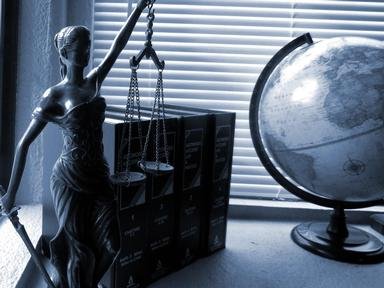Quiz Answer Key and Fun Facts
1. One of the first examples of a diplomatic mission is found in the Bible. Which Israelite king was visited by the Queen of Sheba?
2. The origins of modern public international law can be traced directly from the work of Roman Jurisconsults in the 2nd Century AD. Whose work was particularly influencial in providing an early distinction between civil and international law?
3. What name did the Romans give to their concept of international law?
4. The fall of the Roman Empire was a serious blow to the development of international law until the late 11th Century. What event sparked its resurgence?
5. Another event that sparked a rapid development in the international law was the capture of the Portuguese galleon, the Santa Catalina, by a ship from the Dutch East India company in 1601. This was argued to be a breach of the 1494 Treaty of Tordesillas because the Dutch vessel was in Portuguese waters. Where did the incident take place?
6. Who was the young Dutch lawyer hired by the Dutch East India company to prepare their defence for the capture of the Santa Catalina?
7. The spread of international law to the world was facilitated by the Ching Dynasty ordering the translation of what text into Chinese in 1864?
8. Commodore Perry's expedition to Japan in 1853 marked a watershed in Japanese history in many respects. More significant to the development of international law in Japan was the arrival and tenure of which American Consul-General?
9. Following World War I, Woodrow Wilson came to the post-war negotiations with a plan for a League of Nations to prevent another war between major powers. Which of the following is NOT true about the League of Nations?
10. The United Nations Charter was signed on the 26th June 1945 in what city?
11. The UN Charter brought in more than just the General Assembly and Security Council. Which of the following was also created?
12. Cassese notes that there were two dominant plans regarding how the United Nations was going to preserve world peace. Whose theory has become dominant in the structures of the UN?
13. Which of the following signatories to the Rome Statute of the International Criminal Court had ratified it when it came into force on 1st July 2002?
14. One of the main purposes of the United Nations is to prevent future wars. Which provision of the UN charter actually prohibits the use of force in international relations?
15. Following the launch of Sputnik in October 1957, a whole new frontier was opened up for exploration, exploitation and international law. What is the acronym for the United Nations committee that quickly formed in response?
Source: Author
tkane82
This quiz was reviewed by FunTrivia editor
bloomsby before going online.
Any errors found in FunTrivia content are routinely corrected through our feedback system.
